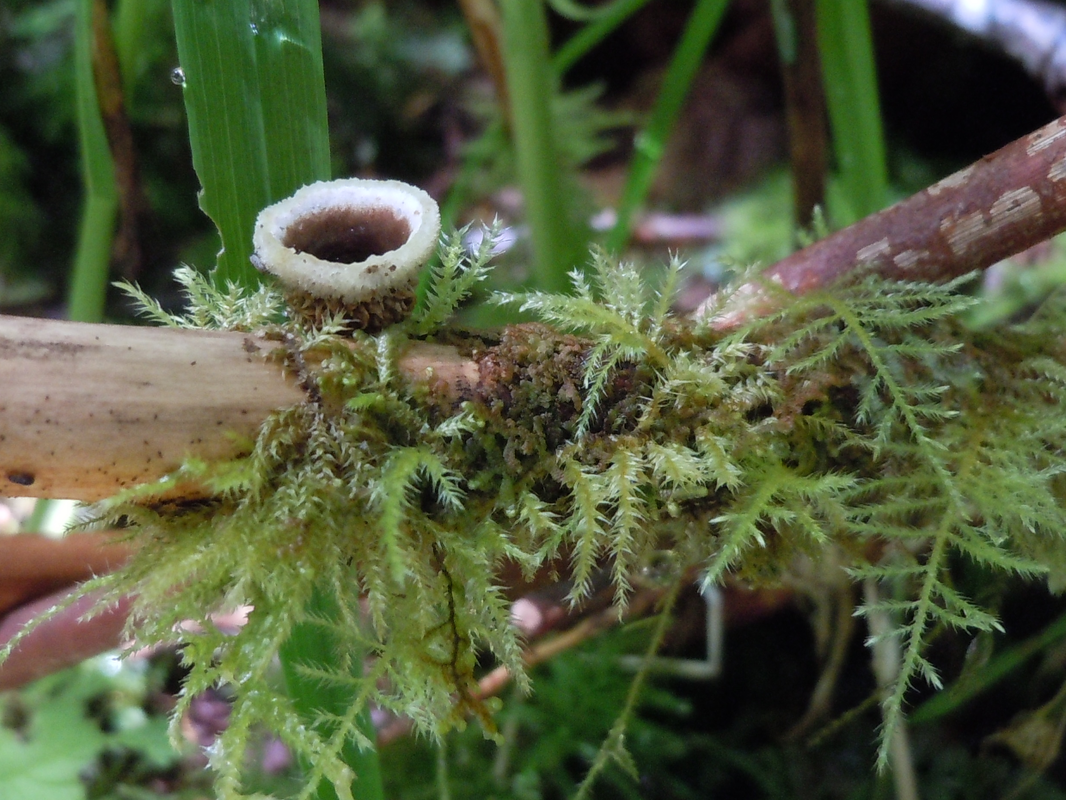Common gel bird's nest • Nidula candida
Identification
Common gel bird's nest belongs to the Nidulariaceae, or bird's nest fungi family, known for fruiting bodies that look like miniature bird's nests with tiny eggs nestled inside. This species has a mug- or flower pot-shaped "nest" (or peridium) with a flared-out rim, and a shaggy grey-brown or brown exterior. The rim is roughly circular, and 3-8 mm in diameter. The nest gets to 1.5 cm tall. The "eggs" (or peridioles) are light grey to brown, 1.5-2 mm in diameter, and sit in a gelatinous substance within the whitish interior of the nest. The eggs may not be visible as the nest is initially covered with a lid; eggs may also be absent altogether if the spores have fully dispersed. See the E-Flora BC species page for more photos and detailed identification information; more photos are also availabe on the CalPhotos species page.
Habitat & Range
The little nest-shaped fruiting bodies of this species grow on soil as well as on decaying wood, the branches of berry plants, and other plant debris. Sometimes new nests grow atop old ones. Fresh nests are mostly found in summer and fall, though old nests may persist. It is found in the Pacific Northwest from Alaska to California.
Similar Species
The white barrel bird's nest (Nidula niveotomentosa) is smaller (to 6 mm tall), shaggy, and white (older individuals sometimes tinged with yellow or brown). It has a slender mug-shaped nest, and is more common in BC than the common gel bird's nest.
Intriguing Info
The "eggs" contain fungal spores, that are dispersed into the air when water drip splash into the nest, which serves as a splash cup.
iNaturalist
https://www.inaturalist.org/taxa/120036-Nidula-candida
Common gel bird's nest belongs to the Nidulariaceae, or bird's nest fungi family, known for fruiting bodies that look like miniature bird's nests with tiny eggs nestled inside. This species has a mug- or flower pot-shaped "nest" (or peridium) with a flared-out rim, and a shaggy grey-brown or brown exterior. The rim is roughly circular, and 3-8 mm in diameter. The nest gets to 1.5 cm tall. The "eggs" (or peridioles) are light grey to brown, 1.5-2 mm in diameter, and sit in a gelatinous substance within the whitish interior of the nest. The eggs may not be visible as the nest is initially covered with a lid; eggs may also be absent altogether if the spores have fully dispersed. See the E-Flora BC species page for more photos and detailed identification information; more photos are also availabe on the CalPhotos species page.
Habitat & Range
The little nest-shaped fruiting bodies of this species grow on soil as well as on decaying wood, the branches of berry plants, and other plant debris. Sometimes new nests grow atop old ones. Fresh nests are mostly found in summer and fall, though old nests may persist. It is found in the Pacific Northwest from Alaska to California.
Similar Species
The white barrel bird's nest (Nidula niveotomentosa) is smaller (to 6 mm tall), shaggy, and white (older individuals sometimes tinged with yellow or brown). It has a slender mug-shaped nest, and is more common in BC than the common gel bird's nest.
Intriguing Info
The "eggs" contain fungal spores, that are dispersed into the air when water drip splash into the nest, which serves as a splash cup.
iNaturalist
https://www.inaturalist.org/taxa/120036-Nidula-candida
References
Gibson, I. Nidula candida (Peck) V.S. White. In Klinkenberg, Brian (Editor). E-Flora BC: Electronic Atlas of the Plants of British Columbia. Lab for Advanced Spatial Analysis, Department of Geography, University of British Columbia, Vancouver. Accessed 19/11/2014.
Phillips, R. Nidula candida. RogersMushrooms. Rogers Plants. Accessed 19/11/2014.
Authors and editors of page
Kelly Fretwell and Brian Starzomski (2014).
Gibson, I. Nidula candida (Peck) V.S. White. In Klinkenberg, Brian (Editor). E-Flora BC: Electronic Atlas of the Plants of British Columbia. Lab for Advanced Spatial Analysis, Department of Geography, University of British Columbia, Vancouver. Accessed 19/11/2014.
Phillips, R. Nidula candida. RogersMushrooms. Rogers Plants. Accessed 19/11/2014.
Authors and editors of page
Kelly Fretwell and Brian Starzomski (2014).





